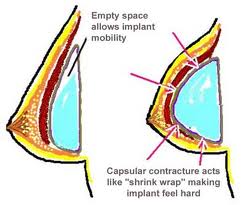
While once the risk of capsular contracture formation was significant, it dropped precipitously when only saline implants were available and most breast augmentations were done in a submuscular location. It is a complication that I do discuss with my breast augmentation patients but whose incidence in my experience that is far less significant than many other potential aesthetic complications.
But what is the real risk of capsular contracture around breast implants in more recent times? In the May 2013 issue of the Aesthetic Surgery Journal, that very question was addressed in a published paper entitled ‘Capsular Contracture Rate in a Low-Risk Population of Primary Breast Augmentation’. Looking at over 800 patients whom underwent first-time placement of breast implants over a ten year period, the authors reported on their incidence of seeing capsular contracture. Their overall incidence was just under 3% with follow-ups that averaged just over one year. The highest incidence was seen in smokers with essentially a 5% rate vs 2% in non-smokers. In surgeries where antibiotic irrigation was used the rate ws decreased from 4% to roughly 0.5%. The greatest association of capsular contracture occurrence was seen in the use of saline implant which were nearly 8X more likely (4.5% vs 1.5%) to have it develop than in silicone implants.
The authors conclude that early capsular contracture rates in breast augmentation can be less than 1%. Using a silicone gel implant placed under the muscle with antibiotic irrigation is associated with the best chance of avoiding this breast implant problem.
Capsular contracture is one breast implant problem that most patients don’t really think or, quite frankly, can really grasp what it is all about. That is not entirely their fault since this scar problem is yet to be well understood by plastic surgeons. We know that it is very real and has always been associated with higher rates of occurrence when the implant is placed above the muscle or develops a hematoma or an infection. It is surprising that in this study the use of saline implants had a higher occurrence since, historically, it was usually seen more in silicone implants. (albeit those that had ruptured)
Dr. Barry Eppley
Indianapolis, Indiana


